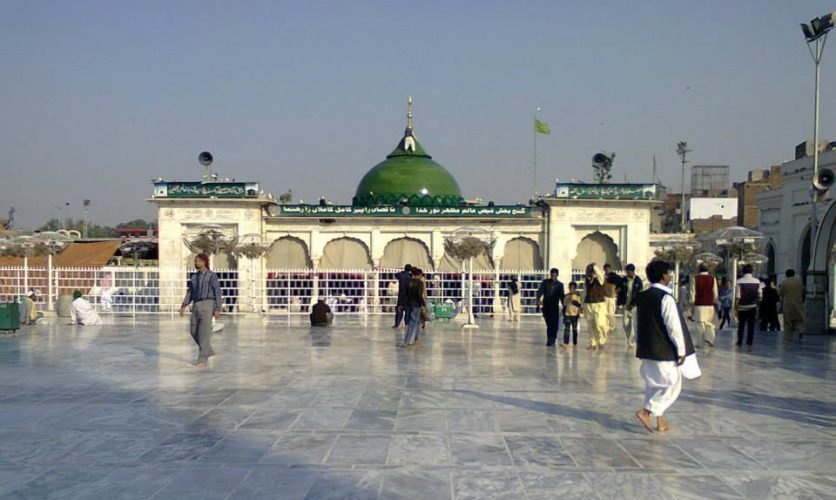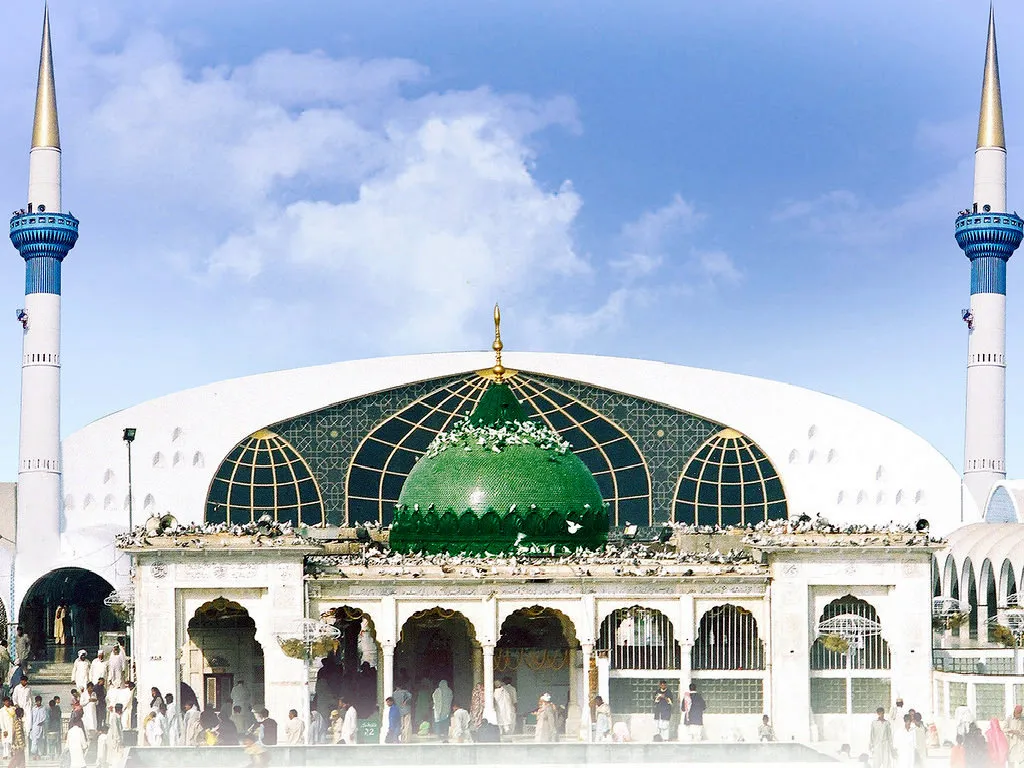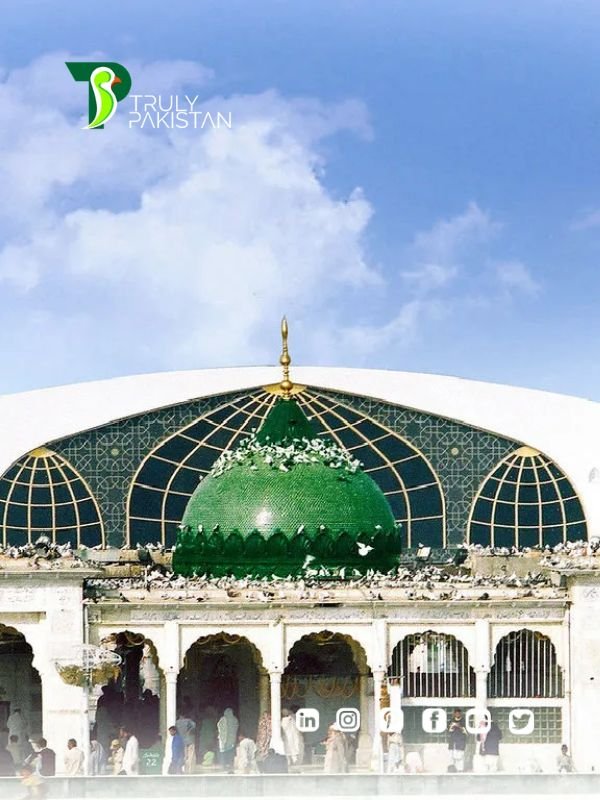Data Darbar Pakistan – History, Architecture, and Significance


Data Darbar Pakistan stands in the heart of Lahore as South Asia’s largest and most visited Sufi shrine. It is the resting place of Hazrat Ali Hujwiri, widely known as Data Ganj Bakhsh, an 11th-century scholar and saint whose teachings shaped the roots of Sufism in the region. Every day, tens of thousands visit this sacred site to offer prayers, share in communal meals, and experience the spiritual calm that defines Lahore’s old city.
Table of Contents
Understanding Data Darbar Pakistan
Where Is Data Darbar Located?
Data Darbar is located in the Bhati Gate area of old Lahore, just off Lower Mall Road. Surrounded by the rhythm of daily life, its white marble structure rises amid centuries-old streets. The shrine is easily accessible from all major parts of Lahore, with dedicated parking and public transport routes leading directly to its gates.
Why Is Data Darbar Important?
Data Darbar Pakistan represents more than a burial place—it is a living symbol of spiritual unity and compassion. The teachings of Hazrat Ali Hujwiri emphasize love, service, and the pursuit of truth. Over centuries, the shrine has become a gathering point for millions, regardless of class or background, symbolizing Lahore’s title as the “City of Saints.”
How Many People Visit Data Darbar Each Year?
According to official figures, between 30,000 and 60,000 devotees visit the shrine daily, with numbers soaring to nearly one million during the annual Urs celebrations. These visitors include both locals and international pilgrims, making Data Darbar one of Pakistan’s busiest spiritual destinations.
History of Data Darbar Pakistan
Early Foundations in the 11th Century
The origins of Data Darbar date back nearly a thousand years, to when Hazrat Ali Hujwiri migrated from Ghazni to Lahore. After his passing around 1071 CE, his followers constructed a small tomb to honor him. Over time, that humble shrine became a center for spiritual study and devotion.
Mughal Era Expansion and Patronage
During the Mughal period, rulers and nobles expanded the complex, adding marble domes, intricate calligraphy, and a grand courtyard. The shrine’s architecture began reflecting Mughal aesthetics—arched gateways, symmetrical courtyards, and finely detailed tile work—signifying both power and devotion.
Modern Renovations and Auqaf Management
Today, Data Darbar is maintained by the Punjab Auqaf and Religious Affairs Department. Major renovations include improved accessibility for women and persons with disabilities, upgraded air conditioning systems, and digital crowd monitoring to ensure safety during peak seasons.
Hazrat Data Ganj Bakhsh Ali Hujwiri
Biography and Journey to Lahore
Born in Ghazni (modern-day Afghanistan) around 990 CE, Hazrat Ali Hujwiri was a scholar, teacher, and traveler in search of divine truth. His journeys took him through Persia, Central Asia, and eventually to Lahore, where he settled and spread the message of love and humanity through Islamic mysticism.
Teachings and Legacy
Hazrat Ali Hujwiri’s teachings revolved around humility, self-purification, and service to others. His disciples describe him as a man of immense learning and compassion, who bridged the gap between the scholar and the seeker. His influence extends across South Asia, and his shrine continues to be a center for spiritual gatherings and reflection.
Kashf al-Mahjub and Its Influence
His famous book, Kashf al-Mahjub (“Revelation of the Veiled”), is considered the earliest known treatise on Sufism. It documents the philosophy and practices of early Sufi saints, combining spiritual insight with clear guidance for seekers. This text remains a foundational reference for Sufi scholars worldwide and is often studied by visitors who come to the shrine.
Architecture of Data Darbar Pakistan
Design and Structure Overview


The shrine’s design reflects a blend of Indo-Islamic and Mughal architecture. Its expansive marble courtyards, gilded domes, and arched entrances create a serene yet majestic atmosphere. Visitors enter through large iron gates into a courtyard that leads directly to the saint’s resting chamber.
Indo-Islamic and Mughal Features
White marble dominates the structure, adorned with floral engravings and intricate calligraphy of Quranic verses. The arched corridors and domes draw from Mughal design traditions similar to those seen in Badshahi Mosque and Lahore Fort, linking the shrine’s art to the city’s broader heritage.
Modern Additions and Accessibility Improvements
In recent years, the shrine has been expanded to include gender-specific prayer halls, an air-conditioned enclosure for pilgrims, and a well-organized entry system. The new lighting and ventilation systems make the site comfortable for the growing number of visitors, while security cameras ensure round-the-clock monitoring.
Urs Festival at Data Darbar
History and Religious Meaning
The Urs of Hazrat Data Ganj Bakhsh is one of Pakistan’s most revered religious events. Celebrated annually to mark the saint’s death anniversary, the festival is not seen as mourning but as a celebration of his spiritual union with the Divine. For devotees, the Urs signifies the timeless bond between teacher and followers—a moment of gratitude for his lasting influence on South Asian Sufism.
Dates, Ceremonies, and Cultural Celebrations
The Urs is held every year according to the Islamic lunar calendar, usually falling in the month of Safar. For three days, Lahore transforms into a city of devotion. The shrine and surrounding streets glow with thousands of lights and floral decorations. Ceremonies include Quran recitations, qawwali music, langar distribution, and the ceremonial washing of the saint’s tomb, known as the ghusl. Visitors from across Pakistan and abroad join the festivities, creating a unique spiritual and cultural atmosphere.
Security, Management, and Visitor Flow
Given the massive attendance—often exceeding one million people—the Punjab government implements a detailed security and management plan each year. Thousands of police officers, rescue teams, and volunteers manage traffic, crowd control, and safety measures. Metal detectors, walk-through gates, and surveillance systems ensure smooth flow during the festival’s peak hours. Despite the crowds, the sense of order and hospitality remains central to the experience.
FAQ – Common Questions About Data Darbar Pakistan
What Is the Significance of Data Darbar?
Data Darbar is the largest Sufi shrine in South Asia and a major center of Islamic spirituality. It honors Hazrat Ali Hujwiri, whose teachings on love and service have influenced generations of believers. The site attracts millions who seek blessings and peace.
When Is the Urs Festival Celebrated?
The Urs of Data Ganj Bakhsh is celebrated every year in the Islamic month of Safar. It lasts for three days and includes devotional music, religious lectures, and community meals. It is one of the most important Sufi events in Pakistan.
Who Was Hazrat Ali Hujwiri?
Hazrat Ali Hujwiri, known as Data Ganj Bakhsh, was an 11th-century Sufi scholar and author of Kashf al-Mahjub. His work documented early Sufi philosophy and remains a key text in Islamic mysticism.
How Old Is Data Darbar?
The shrine dates back nearly a thousand years, established around 1071 CE. It has been expanded and renovated multiple times under different dynasties and continues to be a living symbol of Lahore’s spiritual history.
How Many People Visit Data Darbar Annually?
Approximately 30,000 to 60,000 people visit daily, while annual Urs celebrations attract up to one million devotees from all over the world, making it one of the busiest pilgrimage sites in Pakistan.
Conclusion
Data Darbar Pakistan stands not just as a monument of stone and marble, but as a living testament to the spirit of Sufism. For nearly a thousand years, it has welcomed all—rich or poor, traveler or local, believer or seeker. Its white domes and echoing courtyards carry the prayers of generations, while the aroma of incense and langar remind every visitor of service, humility, and compassion. In a world that often feels divided, the shrine remains a place where hearts unite in remembrance and gratitude. Visiting Data Darbar is more than a cultural experience—it is a journey into the soul of Lahore, and by extension, into the soul of Pakistan itself.
Related post: Tomb of Jahangir Lahore: History, Architecture & Hours


Author: ZunNurain Khalid — Travel & Tourism Specialist, Founder of ExploreX Pvt. Ltd., and advocate for sustainable tourism in Pakistan. With over a decade of experience in digital marketing and destination branding, ZunNurain has worked extensively on promoting Pakistan’s natural and cultural heritage.
References
- Wikipedia – Data Darbar
- Punjab Auqaf and Religious Affairs Department
- Punjab Tourism Development Corporation
- Dawn News – Annual Urs of Data Ganj Bakhsh
- Associated Press of Pakistan – Security Plan for Urs
- The News International – Cultural Heritage Reports
- UNESCO Tentative List – Heritage Sites in Pakistan
- University of the Punjab Journal – Sufi Architecture Studies
- The Nation – Urs Coverage 2024
- Express Tribune – Women Attend Data Sahib’s Urs

